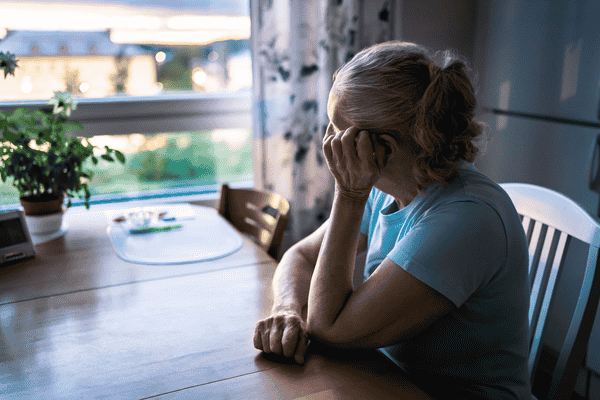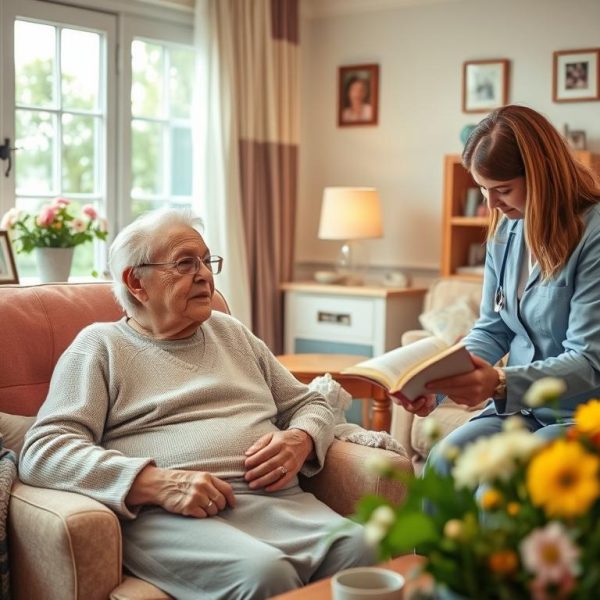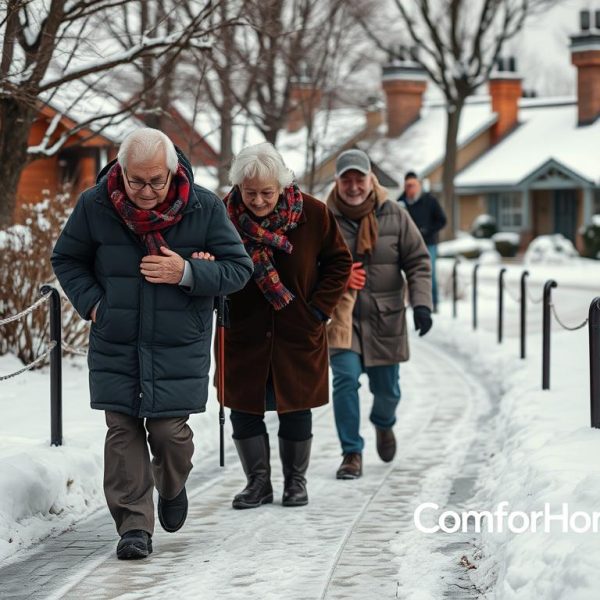Are you concerned about the well-being of an elder loved one who seems isolated or low? You’re not the only one. Loneliness and depression among seniors are on the rise, but there’s a light at the end of the tunnel. In this guide, you’ll discover 10 proven strategies for combating elderly loneliness and depression, which will empower you to make a significant difference.
By facilitating meaningful relationships, and making use of technology, we will investigate the real-life solutions that could benefit a person’s life the most if you are the caregiver, the family, or the older adults’ physician. Thusly, this article is meant to help you:
• Spot the indicators of loneliness and depression in the elderly
• Grasp how isolation from society can lead to depression of both mind and body
• Utilize suitable techniques to make sure of their participation in community life
• Overcome the obstacles created by the pandemic just for a while
Are you ready to improve the quality of the retired people’s lives their? Let us start this journey, showing a more involved and happier world for our elderly loved ones.
Understanding Elderly Loneliness and Depression
Imagine a world where the golden years are tarnished by the shadows of loneliness and depression. This is a whole lot of older people.
Lonely yet depressed old people constituting a rarely addressed crisis is just one more point to highlight about it. Rather than a calm entrance to a retirement period, these men have to go through a chilling battle.
But why does this happen? And more importantly, how can we help?
Let’s dive into the world of elderly loneliness and depression, exploring their roots, impacts, and most crucially, how we can make a difference.
Definition of Loneliness and Isolation in Older Adults
Picture this: An older person sitting alone in a room, surrounded by silence. This is more than just being physically alone; it’s a feeling of disconnection from the world around them.
Loneliness is a subjective feeling of being alone, regardless of the amount of social contact. It’s that gnawing sense that something’s missing, even in a crowded room.
Social isolation, on the other hand, is the objective state of having few social relationships or infrequent social contact with others. It’s like being on a deserted island, even if that island is in the middle of a bustling city.
For many older adults, these experiences intertwine, creating a perfect storm of emotional distress.
💡 Key Takeaways: Loneliness and social isolation are distinct but related concepts that can significantly impact an older adult’s well-being.
Contributing Factors to Social Isolation and Loneliness
Why do older adults find themselves in this predicament? The reasons are as diverse as the individuals themselves.
Imagine a retiree whose children have moved away, leaving them with an empty nest and a sudden void in their daily routine. Or consider a widow who’s lost not just a spouse, but their primary social connection.
Here are some common factors:
– Loss of loved ones: The death of a spouse, friends, or family members can entirely change an elderly person’s social circle.
– Retirement: Leaving the working community can mean the loss of everyday interactions with collegues.
– Health issues: Elderly people may find it difficult to keep their social connections because of mobility issues, chronic illnesses.
– Technology gap: Some elderly people in this digital world may find themselves being left behind.
– Changes in family structures: The busy everyday life of adult children leading them moving away from the family can reduce family interactions.
These points can cause the chain reaction that one loss leads to another and, one after another, older adults’ social networks are broken by this series of losses.
💡 Key Takeaways: There are many aspects involved in fighting against social isolation and loneliness in older adults, besides some personal losses, there are some societal changes as well.
Impact of Loneliness on Mental and Physical Health
Loneliness is not something you can quickly touch and go; it is a crucial health issue that can have a deeper meaning for older adults.
Visualize the loneliness of an older individual as a bulky backpack that he/she has to carry all the time. With time, that emotional burden can become extensive and affect both mental and physical health.
The impacts can be summarized as:
Mental Health Effects
– Depression: Distress caused through isolation can foster negative thinking and feeling.
– Anxiety: If the person is the one always being left out or forgotten then one can anticipate the existence of chronic anxiety and worry.
– Cognitive decline: Research shows that isolated elderly individuals tend to exhibit deteriorated cognitive functions more quickly.
– Low self-esteem: Ongoing feelings of loneliness can result in one feeling valueless in this world.
Physical Health Impacts
– Cardiovascular issues: The link between loneliness and increased likelihood of heart ailments and strokes is pretty direct.
– Weakened immune system: Continuous states of loneliness might distort the immune system’s usual place under the sun-Staying away from friends and relatives illness is inevitable.
– Sleep problems: Sleep deprivation is a typical problem among lonely individuals in return it causes numerous further health problems.
– Increased mortality risk: Evidence indicates that being lonely can be as cancer-causing as smoking fifteen cigarettes daily.
The bond between loneliness and health is often a two-way street. Illness may lead to seclusion, then health worsens as a result.
For example, an elderly person whose movement is limited may find it difficult to join social activities and thus become isolated. This disease loneliness might then aggravate their disease giving rise to a downward spiral.
Addressing loneliness means the older adults’ emotional wellness is not the only thing being improved; it guarantees protection of such folks’ general health and quality life.
💡 Key Takeaways: The adverse effects of loneliness on the mental as well as physical health of aged people are dreadful, this gives rise to the importance of tackling this matter promptly.
Common Signs and Symptoms of Loneliness and Isolation
Recognizing loneliness in older adults isn’t always straightforward. It’s like solving a puzzle where the pieces aren’t always visible.
Here are some signs to watch for:
– Withdrawal from activities they once enjoyed
– Spending most of their time alone
– Expressing feelings of emptiness or worthlessness
– Changes in eating or sleeping patterns
– Increased irritability or mood swings
– Neglecting personal care or household chores
– Excessive focus on minor problems
– Talking about feeling lonely or disconnected.
Remember, these signs might not always be obvious. An older person might smile and say they’re fine, while inwardly struggling with intense loneliness.
For example, your usually talkative grandmother might start making excuses not to attend family gatherings. Or your elderly neighbor, once known for his immaculate garden, might let it become overgrown.
It’s crucial to look beyond the surface and engage in meaningful conversations with older adults in your life. Sometimes, simply asking, “How are you really doing?” can open the door to important discussions about loneliness and isolation.
💡 Key Takeaways: Recognizing signs of loneliness in older adults requires attentiveness and open communication, as these symptoms can often be subtle or hidden.
The Importance of Social Connection in Preventing Depression
Picture social connections as a safety net, catching older adults before they fall into the depths of depression. That’s how crucial these connections are in maintaining mental health.
Having close relationships within your community is a big help when you are confronted with challenges in your life. They provide:
– Emotional support: Talking helps ease tension and control negative thoughts that can become overwhelming.
– Sense of belonging: Membership of a group or community is suggestive of one’s purpose.
– Mental stimulation: Interaction encourages active thought.
– Physical activity: Most social events involve physical exercise thus improving general health.
Take the case of Maria. She was 75 and a widow. The day she joined the book club also was the day she found that her old passion was back again. She was no longer alone. Instead, she had a group of friends with whom she could share. The book club day gave her something to look forward to, fireplace and the books, while keeping the sad thoughts about her husband aside.
Not only that. Studies have reaffirmed this. People in their senior years who are social members of the community are less likely to suffer from depression and they tend to age with better mental capabilities.
Nevertheless, the emphasis is on depth, not breadth. Especially the ones that make one feel heard and valued are significant blockers to depression among the young.
For example, having a trusted friend to off-load your worries on could provide more solace than many bowl buddies.
Reacting positively and encouraging the right social networks can be powerful levers in decreasing stress levels in older adults. Be it a visit from family or friends, a community project or a WhatsApp video call with your grandkids, connections are just as essential.
💡 Key Takeaways: There is compelling evidence that strong and quality social bonds can help shield older adults from depression consequently, the need to cultivate these people’s relationships needs to be the top priority.
10 Proven Strategies to Combat Elderly Loneliness and Depression
Are you interested in discovering ten impactful methods which could change the lives of elderly people who might be dealing with loneliness and depression?
1. Fostering Social Connections
Consider social connections as pathways, which join seniors to a culture of friendship and support.
Here is how to establish relationships:
– Have regular family gatherings: Regular dinners or monthly meetings can ensure continued social engagement.
– Help them make connections with friends: Help elderly adults set up connections with other seniors with similar lifestyles.
– Get them involved in the community: Arrange for them to go to activities or events which are common in the weekends.
For instance, 68-year-old John, he was able to come to an event held by his local chess club which he was a member. It really was a test of his intellect as well it was a possibility for him to meet a group of like-minded people.
Be reminded that what counts is both quality and quantity. Having long-term excellent relationships could be a very important factor towards changing the future more than having a lot of very superficial ones.
💡 Key Takeaways: Doing the right social connection work is the most effective way to bring down the loneliness of the elderly.
2. Leveraging Technology for Connection
Nowadays technology seems to be a very strong means of giving people emotional comfort when they are apart.
Here’s how:
– Video calling education: Video-calling platforms that assure that family are close even when they are far away such as Skype or FaceTime can be taught to the elderly.
– Use social media: Facebook or Instagram can be useful for older adults to keep in touch with their friends and family.
– Websites: The elderly can have a place of belonging on interest-based forums or groups.
For example, at the age of 75, Sarah was taught how to use a tablet. At present, she has weekly video calls with her grandchildren and takes part in an online book club at the same time.
However, it is very important to help and be patient while using new technology. Start with a simple one and gradually step up the complexity.
💡 Key Takeaways: Older adults can be socially connected and involved through technology, but for this to happen the technology should be easy to handle.
3. Partaking in Community Programs and Support Services
Community programs are of great importance to socially isolated and lonely older adults, as they provide structured opportunities for social engagement.
The following avenues can be considered:
– Storage centers: They are a great way for older adults to connect through activities and classes caused.
– Adult education programs: This is a good way to learn and gain experience and an effective way to socialize.
– Probation programs: It is the reason why people think they are the perfect solution to serve society and find friends.
Seventy-year-old David, for example, found himself built in by giving shelter to animals at a local shelter. He was able to make friends and was valued for his input.
Local organizations normally have the necessary resources for the elderly in particular. One must not be shy to contact them and check the choice of solutions to the problem existing in the work.
💡 Key Takeaways: Older adults are provided with community service programs that have socially engaging, knowledge-exchanging, and purpose-driven activities.
4. Promoting Intergenerational Connections
Both older adults and younger people can get incredible satisfaction from closing the gaps between the generations.
The following ways can be counted to create those connections:
– Mentoring programs: Older adults have the opportunity to share their life wisdom with the younger generation.
– Intergenerational living arrangements: Some communities offer housing arrangements where elderly people live with university students.
– Family history projects: Ensure that the grandchildren interview their grandparents to get their life histories.
Consider 80-year-old Margaret, who began introducing knitting into the local youth club. She had a feeling of getting fulfillment from her upskilling and shifted some responsibilities to the young people.
Through these bridges, older persons develop a sense of being appreciated and receiving a new look at life while the other generations are learning from them and getting hints through guidance.
💡 Key Takeaways: Connecting the elderly to the youngsters can produce both ways, in which old people may feel useful and youngsters can be educated through practical shows of life lessons.
5. Encouraging Volunteer Activities
Giving back is only one side of volunteering. It is getting the feeling of life purpose and connection by doing so.
Look at these opportunities for volunteering:
– Local libraries: Helping with reading programs or organizing books.
– Hospitals: Offering the company of patients or helping with non-medical objectives.
– Schools: Many tutors and after-school programs give a helping hand.
A local food bank was where a 72-year-old man named Tom saw hope through volunteering. He not only made something for himself, but he also sat with others and made friends.
This platform helps older people to be able to use their skills and knowledge, as well as feel good about themselves and achieve the feeling of winning.
💡 Key Takeaways: Participating in voluntary acts will help the older adult to keep himself/herself occupied, get engaged with the community and get the power to solidify important relationships.
6. Joining Support Groups
Support groups can come in handy for older adults dealing with similar problems.
Here are the advantages they bring:
– Member’s stories can be the same as each other’s suffering.
– Emotional support is found in groups where members can openly express their sentiments in a secure environment.
– Members can offer practical solutions and direct help by sharing their own resources and problem-solving techniques.
Maria, for example, became a part of a widow support group. She both gained solace from talking about the loss she was experiencing and received practical advice from other women’s issues group members.
Search for support groups targeting primary issues like bereavement, chronic illness, or general well-being of the elderly.
💡 Key Takeaways: Groups of supporters in which older adults face similar problems will be a fusion of support that includes understanding, emotional support, and practical advice.
7. Participating in Educational Programs
Learning is a lifelong journey that older adults can also take to be connected and involved.
Suggestions include examples of such educational opportunities:
– College courses at the community: A lot of community colleges offer senior discounts or free classes.
– Online courses: A variety of subjects are available on platforms like Coursera or edX.
– Local workshops: Educational events are held by libraries or community centers often.
A good example of this is Alice, 68, who took a watercolor painting classes at her local arts center. She not only learned a new skill but also developed friendships with the other students.
Education programs encourage the mind, give a sense of fulfillment, and create chances for social interactions.
💡 Key Takeaways: Going to educational programs can help older adults with both mental stimulation, a sense of accomplishment, and communication as a part of a community.
8. Engaging in Physical Activities
Staying active is healthy not just for the body, but also for the mind and social life.
Here’s a choice of activities:
– Group exercise classes: Yoga, tai chi, or water aerobics explicitly for seniors.
– Walking groups: Regular group walks provide an opportunity for social contact and exercise.
– Go dancing: Having fun dancing is a great social activity like going to classes is an option.
A 75-year-old George, for example, was part of a senior bowling group to help seniors who had various health issues. This club facilitated his taking back the responsibility of his exercises and the three new pals he made his out go of this weekly games life.
Choose an activity that is the most interesting and is within the limits of one’s capability. A doctor should always be consulted before joining a new exercise program.
💡 Key Takeaways: Active engagement in health-promoting activities specifically designed for elderly people can significantly enhance their health, uplift their spirits, and create the opportunity for precious social interaction.
9. Utilizing Companionship Services
Professional companions service can sometimes stand in when family or friends can’t.
Such services typically include:
– Regular visits for talking and companionship
– Help with light household chores
– Going to social outings or appointments
Choose Martha who is an 85-year-old woman who lives alone. She is paired with Sarah in a companionship service that comes twice a week. During their time together, they share pleasantries and interests such as cards or walking together. Therefore, Martha regularly interacts with other people.
These services are not a substitute for deep personal relationships; however, they can help in maintaining steady, social contact, and emotional support.
💡 Key Takeaways: Professional companion services can enable older adults to have regular social contact and emotional support even when they are less sociable.
10. Seeking Professional Help
At times, feeling lonesome and melancholy requires professional intervention.
Here’s when and how to seek help:
– Stop the signs: Long-term unhappiness, loss of interest in the activities previously enjoyed, or irregular sleep habits.
– Visiting a family doctor: He or she has the ability to rule out physical illnesses and give referrals to specialists.
– Treatment by a psychologist: Cognitive Behavioral Therapy (CBT) is a very powerful treatment for elderly people suffering from depression.
For example, Frank, 70 years old, was initially resistant to going into therapy initially. Still, no sooner had he completed a few sessions than he was already on the path of learning how to deal with his situation, feeling empowered by a new perspective on it.
Be assured that looking for help is not showing weakness but strength. Mental health is no less important than physical health.
💡 Important Points: For older patients suffering from the chronic loneliness as well as depression, professional mental health services may prove to be decisive.
How Healthcare Providers Can Help Reduce Loneliness
Health care professions are right there in the frontline of the war against loneliness and depression of the elderly. They act like detectives in the investigation, searching for the indications of the psychological and social difficulties faced, in particular, by older people.
Here is what healthcare providers can do:
– Routine tests: Evaluating loneliness during every medical examination.
– Unrestrained dialogue: Establishing the connection between doctor/doctor and patient for the patient to be secure in talking about social and emotional issues.
– Entire approach: Identifying the relationship between the individual’s health and the social well-being of the community.
In one instance, Elizabeth took cognizance of her patient aged 78 years by the name Betty that she was more withdrawn during the consultations. During a gentle quiz, she came to know that she was feeling lonely in her new neighborhood where she had just moved. Dr. Johnson was able to refer Betty to local senior center programs.
They are also able to:
– Deliver a presentation on the significance of social ties
– Offer resources for community engagement
– Collaborate with mental health professionals when necessary
Remember, the goal is to treat the whole person, not just physical symptoms.
💡 Key Takeaways: Healthcare providers play a crucial role in identifying and addressing loneliness in older adults, emphasizing the importance of a holistic approach to health care.
Comprehensive Assessments for Identifying Loneliness in Patients
To understand if older adults feel lonely, the caregivers need to ask open-ended questions instead of stick to only those, “Do you feel lonely?” The assessment must present a solid understanding of the patient’s social and emotional health.
A comprehensive assessment includes the following:
– Standardized questionnaires: Standardized instruments like the UCLA Loneliness Scale serve as valid markers.
– Social network mapping: a visual representation of the social system and support for the patient.
– Daily activity review: an examination of how a patient spends their time, both socially and otherwise.
In one illustrative example, despite being a part of a large family, the patient did see them instead, the doctor partially who was evaluating her loneliness, and her friend who also socialized with some of these family members reported on her behalf.
Such evaluations provide healthcare professionals with the opportunity to design individual interventions tailored to each particular case.
💡 Key Takeaways: Comprehensive assessments are a blend made up of the methodologies that are standardized and conversations that last for long periods. They are essential for inclusive evaluations of loneliness in older patients.
Conclusion
In conclusion, our exploration of the “10 Proven Strategies to Combat Elderly Loneliness and Depression” has highlighted an important fact that social connection is extremely necessary for both the mental health and well-being of older adults. By using these techniques, we can provide substantive assistance to our older family members by reinforcing their social ties and upgrading their and improving their lifestyle.
It is of the utmost importance to acknowledge that the elderly’s loneliness and depression-mitigating activities are a collaborative procedure. The participation of family members, health officials, and other community groups is basic for achieving that goal. Providing constant support, by creating a conducive environment, organizing social activities, and providing mental stimulation for older people, when done collaboratively we will promote socialization among them.
Let us act today in any way possible so that no elderly person feels alone and forgotten any longer. Every endeavor counts be it as small as giving phone calls to them, or being part of community programs connected through technology. A joint effort can be a one-stop solution where all seniors feel appreciated, attached, and alive.









Hello, Neat post. There is a problem with your web site in web explorer, could check thisK IE nonetheless is the marketplace leader and a large component to folks will pass over your wonderful writing because of this problem.
With havin so much content do you ever run into any issues of plagorism or copyright violation? My website has a lot of completely unique content I’ve either written myself or outsourced but it looks like a lot of it is popping it up all over the internet without my agreement. Do you know any techniques to help reduce content from being ripped off? I’d certainly appreciate it.
I believe you have mentioned some very interesting points, thankyou for the post.
Very interesting topic, thanks for posting. “Not by age but by capacity is wisdom acquired.” by Titus Maccius Plautus.
I simply couldn’t depart your web site before suggesting that I actually enjoyed the standard info a person supply on your guests? Is going to be again often to check up on new posts
I have been exploring for a little bit for any high quality articles or blog posts on this sort of area . Exploring in Yahoo I at last stumbled upon this website. Studying this info So i’m glad to exhibit that I have a very excellent uncanny feeling I came upon exactly what I needed. I most unquestionably will make certain to don’t overlook this site and give it a glance on a relentless basis.
Very interesting subject, thankyou for putting up. “Remember when life’s path is steep to keep your mind even.” by Horace.
Hi my friend! I want to say that this post is awesome, nice written and include approximately all vital infos. I would like to see more posts like this .